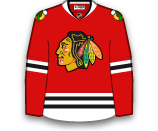Wagner has a goal, five SOG, and a -3 plus/minus through three games this season but will take a seat Thursday vs. Vancouver as a healthy scratch. The 25-year-old will be replaced by Anders Bjrok in the Blackhawks' lineup.

Wagner has a goal, five SOG, and a -3 plus/minus through three games this season but will take a seat Thursday vs. Vancouver as a healthy scratch. The 25-year-old will be replaced by Anders Bjrok in the Blackhawks' lineup.

Tinordi has two goals, six assists, 32 SOG, 38 PIMs and a -12 plus/minus through 43 games this season and will be a healthy scratch Thursday vs. Vancouver. He will be replaced by Andreas Englund in the Blackhawks' lineup.

Englund has been a healthy scratch for the Blackhawks' previous two games but will draw back into the lineup Thursday vs. Vancouver. The 27-year-old has three assists, 28 SOG, 30 PIMs and a -2 plus/minus through 43 games played between Colorado and Chicago this season.

Blueger has four goals, 12 assists, 81 SOG, 30 PIMs and a -9 plus/minus through 61 games played between Pittsburgh and Vegas but will be a healthy scratch Thursday. The 28-year-old will be replaced by Mike Amadio in Vegas' lineup.

Amadio was a healthy scratch for the Golden Knights' previous game but will draw back into the lineup Thursday vs. Los Angeles. The 26-year-old has 14 goals, 10 assists, 94 SOG, 10 PIMs and a -1 plus/minus through 63 games this season.

McWard had nine goals, 12 assists, eight PIMs and a -5 plus/minus through 39 games with Ohio State University (NCAA) this season and has signed a two-year, entry-level contract Tuesday. The 21-year-old undrafted defenseman will make his NHL debut on Thursday vs. the Chicago Blackhawks.

Raska had four goals, 11 assists, 121 PIMs and a -6 plus/minus through 53 games with the San Jose Barracuda (AHL) this season and has been recalled with expectations to make his season debut for the San Jose Sharks Thursday. The 21-year-old has previously played in five career NHL games, with seven PIMs and a +1 plus/minus.

Livingstone had eight goals, 27 assists, 30 PIMs and a +10 plus/minus through 39 games with Minnesota State University - Mankato (NCAA) this season and is expected to now make his Nashville debut Thursday vs. Carolina. The 23-year-old defenseman was an undrafted free agent who signed with Nashville last week.

DeAngelo has 11 goals, 31 assists, 174 SOG, 73 PIMs and a -27 plus/minus through 70 games this season but will be a healthy scratch Thursday. The 27-year-old has surpassed the 40+ point mark for the third time in four years this season.

Sharangovich was a healthy scratch for the Devils' previous game but will draw back into the lineup Thursday as they take on Columbus. The 24-year-old has 13 goals, 16 assists, 123 SOG, 14 PIMs and a -6 plus/minus through 71 games so far this season.

Kessel failed to pick up a point but had three SOG, and a -1 plus/minus through a short two-game showing with St. Louis but has been assigned back to Springfield (AHL) on loan Thursday. The 22-year-old has five goals, 26 assists, and 64 PIMs through 66 games with Springfield prior to his original promotion.






Timmins has two goals, 12 assists, 15 SOG, eight PIMs and a +1 plus/minus through 23 games with Toronto this season but will be a healthy scratch Tuesday vs. Columbus. The return of Mark Giordano (rest) and Jake McCabe (rest) make Timmins the odd man out of Toronto's lineup.

McCabe rested for the Maple Leafs' previous game but will draw back into the lineup Tuesday as the team takes on Columbus. The 29-year-old defender has three goals, 20 assists, 87 SOG, 50 PIMs and a +12 plus/minus through 70 games between Toronto and Chicago this season.

Giordano took a breather for the Maple Leafs' previous game but will be back in the lineup Tuesday as the Maple Leafs take on Columbus. The 39-year-old has been a model of consistency this season, with his four goals, 24 points, 101 SOG, 53 PIMs and +26 plus/minus through 74 games played.

Marner rested for the Maple Leafs' previous game but will draw back into the lineup Tuesday as they take on Columbus. The 25-year-old star is just two points from his career high in points (97) as he has 28 goals, 67 assists, 180 SOG, 28 PIMs and a +16 plus/minus through 75 games played.
